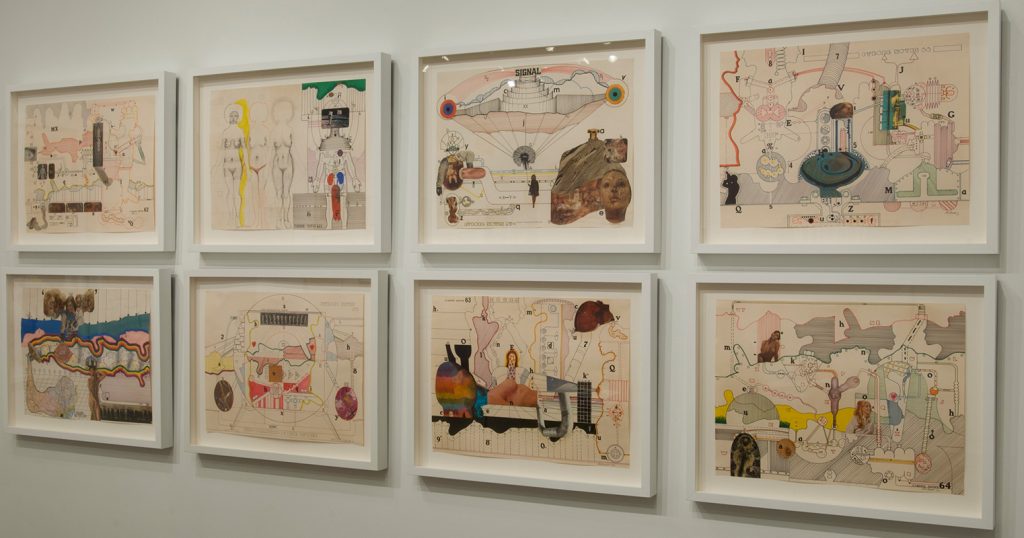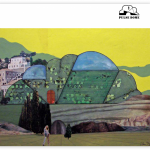

Born in Saunderstown, Rhode Island, in 1929, Don ZanFagna has a degree in art, architecture, and design from the University of Michigan and a MFA in painting from the University of Southern California. During the Korean War, he served as a fighter pilot. Following his discharge, he received a Fulbright/Italian Government Grant for study in Italy, in 1956–57. In the late 1960s, after relocating from California to New York, ZanFagna chose to remove himself from the commercial art world. He was more interested in the research and process of his art than its promotion or sale. In the 1970s and ‘80s, he was the chair of the art department at Rutgers University. The following decade, he was Visiting Eco-Architecture Professor at Pratt Institute. Now in his eighties, ZanFagna, with Joyce, his wife of fifty-five years, has retired near Charleston, South Carolina.
Don ZanFagna:
INFRA/ULTRA
Directed by Christopher Hanson and Aaron Neu
Original Soundtrack: Bill Carson
Executive Producer: Mark Sloan
Don ZanFagna’s notebooks provide an intimate look into the artist’s mind. Because the notebooks are somewhat fragile, they could not be handled by the general public. Instead, we commissioned videographers Christopher Hanson and Aaron Neu to provide a “fly-through” of ZanFagna’s notebooks in the form of a video. An original musical score by Bill Carson accompanies the visuals.
Following ZanFagna’s lead, Bill Carson did research into the Mesoamerican (Mayan) calendar system. He based his musical compositions on the overlapping cycles contained within this calendric system (embedding a 20 note melody over a 13 beat bass line, for example). The result is, predictably, hypnotic.
Slide montage by: Brian Damage
“FORM FOLLOWS FREQUENCY… The visual information presented here comes from my slides. It is material I have been collecting for a number of years and relates DIRECTLY to the central philosophic and thematic aspects of INFRA/ULTRA. The derivation and meaning of INFRA/ULTRA has been stated elsewhere in I/U notebooks and has been directly and indirectly recorded in slides, models, drawings, diagrams, conceptual art/architectural collages and drawings, and other forms. To quote directly from I/U Flare Sheet #1, Jan 68 – The invisible will become more visible – already contours, patterns, densities of the NEW… and NEWER are getting clear… There is a different consciousness trying to break free – the hardware is only mechanism; we need new metaphors of IMAGINATION and SPIRIT. Can we derive sociological, psychological, artistic, architectural, environmental equivalents of EKG’s voiceprints, sonograms, cutaneous communications, x-rays, oscillograms, telemetry, etc.?? What has happened to PROCESS? What is NATURAL? ARTIFICIAL? The boundaries are blurring. We don’t need BULK any longer. We need NEW interfaces, NEW resonance ranges, NEW global linkages of people, pataphysical frequencies and free exchange… alterations in information controls, NEW art, NEW architecture – a whole-life sensory and structural release from 15,000 years of psychophysical and environmental dead-weight!” – ZanFagna
The Halsey Institute has commissioned Clemson Architecture Center in Charleston to create a structure inspired by Don ZanFagna’s forward-thinking concepts of architecture and materials. The architecture students in Studio V, led professor by David Pastre, are working on a semester-long project researching Don ZanFagna and his dream domes, along with other 70s era eco-pioneers. How the students interpret the material will be unveiled on Saturday, December 8 after the closing symposium. This will mark the Halsey Institute’s sixth collaboration with Clemson’s Architecture program.
Follow Studio V’s progress on their blog: http://caccstudiov.com/
The Pulse of Charleston panel discussion will feature local architects and preservationists. How are Don ZanFagna’s theories reflected in Charleston? One can argue that historic buildings and their preservation embodies the concepts that he was trying to promote – perhaps in surprising ways. The discussion will take place at in the Halsey Institute’s galleries and attendees will be surrounded by the work of Don ZanFagna. The exhibition will open at 5:30pm and the panel will begin at 6:00pm. Panelists include Mark Sloan, Director and Senior Curator of the Halsey Institute; Winslow Hastie, Chief Preservation Officer for Historic Charleston Foundation; Reggie Gibson, architect with Gibson Guess Architects and Whitney Powers, President of Studio A. Inc. A reception will follow the discussion. Co-sponsored by Historic Charleston Foundation.
A symposium entitled Bio-Logical Architecture: Past, Present, and Future will be presented on the last day of the exhibition, Saturday, December 8. The Halsey Institute will bring Linda Weintraub, an eco-art-architecture writer, and William Katavolos, an architect and designer, together with the Halsey Institute’s curator Mark Sloan to discuss eco-bio-architecture. The speakers will explore the cultural climate of the 1970s and present various competing alternatives to conventional architecture. A reception will follow in the Halsey galleries. The symposium is co-sponsored by the College of Charleston’s First Year Experience program and the Halsey Institute.
The symposium will begin at 2:00pm in the Recital Hall in the Simons Center for the Arts at 54 St. Philip Street. The symposium and reception are free and open to the public.

Published by the Halsey Institute of Contemporary Art to accompany the exhibition Pulse Dome Project: Art & Design by Don ZanFagna, the catalogue includes an essay by Mark Sloan, senior curator and director at the Halsey, as well as words by the artist, Don ZanFagna.
42 pages.
Softcover.
Price: $10
+ shipping and handling
Click here to purchase your copy.
As a Halsey Institute member, you could receive 20% OFF this publication and all Halsey merchandise!
The Halsey Institute of Contemporary Art at the College of Charleston, South Carolina has produced this traveling exhibition and its attendant activities. Funding has been provided by generous grants from the Graham Foundation for Advanced Studies in the Fine Arts and the Bishop Family Foundation.
Curator: Mark Sloan
Associate Curator: Kirsten Moran
Curator of the ZanFagna Foundation Collection: Allison Williamson
Research Associate: Lauren Frances Moore
Graphic Design: gil shuler graphic design
Framing: Artizom
Video sketchbook fly-through: Christopher Hanson and Aaron Neu
Slide montage: Brian Damage
Special thanks:
ZanFagna and White families
Cortney Bishop
SPONSORS
Special recognition
Amber and John Howe
Patricia C. Alexander
Richard Bridges
Wendy and Steven Dopp
Joan and John Hackenberg
Marge Lawson and Jimmy Baldrick
Kate Nevin
Susan W. Ravenel
Dee and Mac Rhodes
Allison and Bright Williamson
AIA Charleston
Francis Marion Hotel